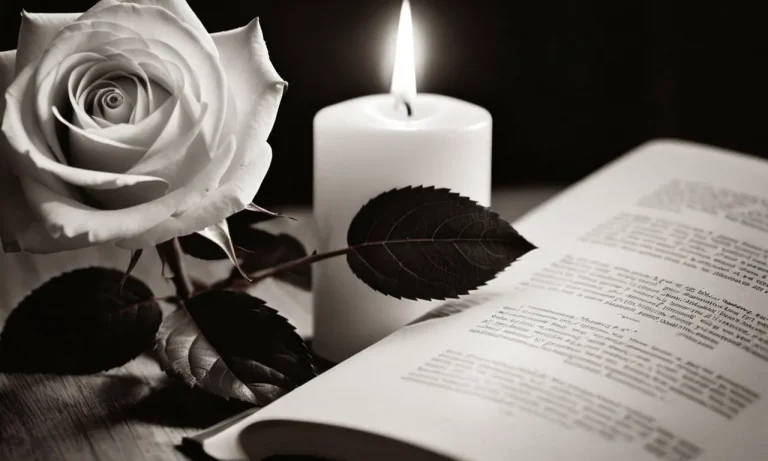The black heart emoji 🖤 has become an increasingly popular way to express dark, gothic, or alternative vibes. But beyond the aesthetic trend, many wonder if the symbol holds deeper spiritual meaning. If you’re short on time, here’s a quick answer: While not directly tied to one spiritual tradition, the black heart can represent standing in your authentic power, embracing shadows, or devotion to a divine feminine ideal.
In this comprehensive guide, we’ll explore the black heart symbol from psychological, mystical, and cultural lenses to uncover its spiritual significance. We’ll look at Jungian shadow work, goddess archetypes like Kali and Lilith, punk/goth subcultures, and more to better understand what it means to have or embody a “black heart.”
The Black Heart as a Shadow Symbol
Connections to Jungian Shadow Work and Owning “Darkness”
The black heart can represent our “shadow selves” – aspects of ourselves that we find unacceptable and repress into our unconscious minds, as described by renowned psychiatrist Carl Jung. Owning and integrating our darkness is key to becoming whole, says Jung.
This includes facing uncomfortable emotions like jealousy, aggression, or greed.
Owning the shadow connects deeply to the journey of self-discovery. As we explore facets of ourselves that we have locked away, we gain profound wisdom into our psyches, motivations, and behaviors. This empowers us to operate from a place of wholeness instead of a fractured sense of self.
Letting Go of Fear and Misconceptions Around “Evil”
The black heart is often misconstrued as something “evil” or dangerous that should be avoided. However, darkness exists in each one of us – the kindest, most virtuous people have aggressive, selfish impulses.
As we shed light on our shadows through self-reflection, we realize that darkness is not something to fear, but rather something that provides depth, dimension and understanding to our experience as humans.
Rather than judging the uncomfortable facets that emerge from our shadow work, we can practice self-love and self-acceptance around these long-hidden pieces of ourselves. We can also reframe darkness as a teacher on our paths, showing us where inner work and integration is still required for wholeness.
Integrating and Transforming Shadow Material
As we explore our shadows, we arrive at a crossroads: Will we continue to repress, deny, and project our darkness onto others? Or will we have the courage to integrate these disowned facets back into ourselves?
The work lies not in eliminating darkness – this is impossible – but transforming our relationship with it. Shadow integration leads to embracing the whole of who we are – light and dark. With compassion and care, we withdraw the projections we have flung onto others, reclaiming all pieces of us.
This is profoundly liberating and empowering work filled with self-love and acceptance.
Owning our shadows also enables us to channel darkness productively, rather than destructively. Passion fueled aggression can transform a social justice movement. Sexual energy can vitalize creative output. Ambition can drive powerful innovation.
The darkness we’ve feared for so long becomes an incredible source of personal power when positively directed. The black heart comes to symbolize a unified, non-judgemental relationship with the self.
Goddess Archetypes and the Divine Feminine
The Dark Goddess Kali and Destruction/Creation Cycles
In Hindu tradition, the fearsome Dark Goddess Kali symbolizes the cyclical processes of destruction and creation. Like nature, she can be both nurturing and destructive. Kali’s association with death highlights the temporality of the world we inhabit.
Her mythology emphasizes that nature must break down and decompose things before giving rise to new life.
Kali’s dark and often terrifying imagery shocks us out of complacency and forces us to confront the ephemeral nature of existence. The goddess compels us to transcend our fear of mortality. By embracing Kali, we make peace with dying and tap into deep spiritual wisdom to accept life’s impermanence with grace and maturity.
Lilith and Reclaiming Feminine Power/Sexuality
In Jewish mythology, Lilith was Adam’s first wife who refused to submit to him and fled from the Garden of Eden. She represents female defiance of patriarchal control and expresses feminine independence and sexuality freely, according to her own desire.
Modern women find inspiration in Lilith’s story of rebellion. This archetype encourages all people to resist oppressive norms, shake loose restrictive labels, and live boldly outside the box. By embracing the Lilith archetype, we claim our authentic voice and sexual sovereignty.
Morrigan and Celtic Underworld/Afterlife Concepts
In Celtic legends, the mysterious Morrigan traverses the realm between life and death. She can shapeshift into a raven and foretells the fate of warriors. The Morrigan rules over magic and crossing mortal boundaries into shamanic states of reality.
As an Underworld goddess close to human suffering, the Morrigan imparts courage and consolation to souls passing into death. Her vision pierces earthly illusions and stays steady in crisis. The Morrigan teaches us to develop inner sight during difficult transitions and reinforces the timelessness of spirit.
Cultural Contexts: Goth, Punk, Alternative Scenes
Aesthetic Signifiers and Dark Romanticism
The black heart symbol has been widely adopted by goth, punk, and alternative subcultures as an aesthetic signifier that aligns with their darkly romantic sensibilities.
Goths in particular are drawn to the black heart for its representation of sorrow and melancholy as well as its deviation from brighter, more colorful mainstream norms. As blogger Miss Maven puts it, “The black heart ‘gets’ us in a way that people find morbid and odd.”
Resistance, Catharsis, and Rejecting the Mainstream
For many in these scenes, wearing or displaying the black heart demonstrates resistance against the mainstream and mass culture’s expectation of happiness and conformity. It allows them catharsis and space to fully feel and process life’s darker emotions.
Punk fashion historian Valerie Steele notes, “I think there’s a certain kind of person who feels profound alienation from mainstream culture and who discovers in Goth culture ‘their people’…people who value things that the mainstream does not understand. “
Finding Belonging When You Feel Like an “Outsider”
This sense of finally finding one’s community and people is key. Though goths, punks, and alternatives may feel like “outsiders” in the mainstream world, sporting black hearts and dark aesthetics brings a powerful feeling of belonging and acceptance within their own scenes and spaces.
| Scene | Black Heart Significance |
|---|---|
| Goth | Sorrow, romanticism, darkness, melancholy, morbid interests |
| Punk | Rebellion, resistance, anger, alienation, nonconformity |
| Alternative | Catharsis, introspection, feeling “different”, finding belonging |
So while the mainstream may see these groups as strange or depressing, sporting black heart imagery allows members to fully embrace their shadow sides among those who “get” them – perhaps the most freeing feeling there is.
Conclusion
Whether you resonate with shadow integration concepts, goddess archetypes, or alternative subcultures, the black heart ultimately represents a bold embrace of what mainstream culture may label as “dark.”
But rejecting dualistic notions of good vs. evil, this symbol empowers people to stand fully in their truth and authentic being.
The next time you use the 🖤 emoji or see someone else sporting black hearts, consider the deeper spiritual wisdom calling to be expressed. Have the courage to acknowledge and integrate your own shadows, let go of limiting ideas about darkness, and walk your unique path with passion and power.






